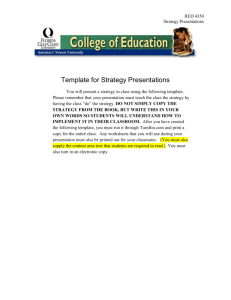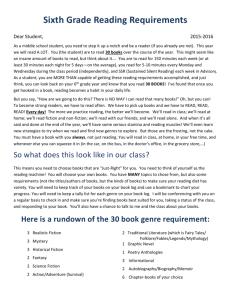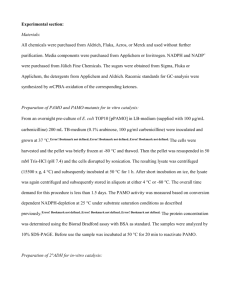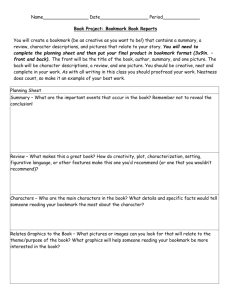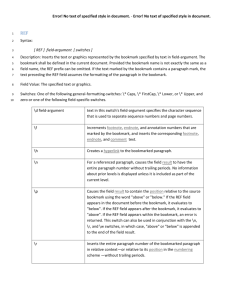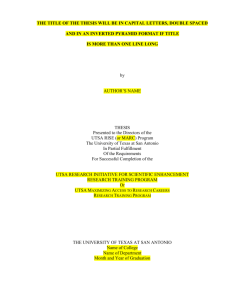The Art of the Possible: page 1-16
advertisement
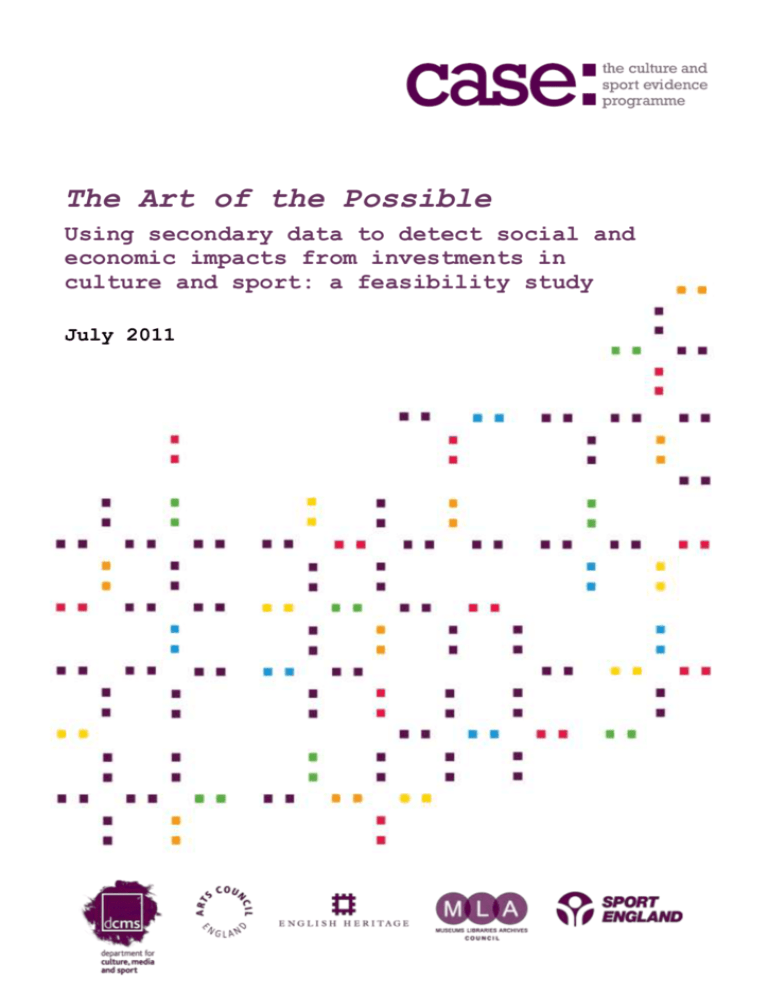
The Art of the Possible Using secondary data to detect social and economic impacts from investments in culture and sport: a feasibility study July 2011 The Culture and Sport Evidence (CASE) programme is a joint programme of research led by the Department for Culture, Media and Sport (DCMS) in collaboration with Arts Council England (ACE), English Heritage (EH), the Museums, Libraries and Archives Council (MLA) and Sport England (SE). TBR1 and the Cities Institute2 were commissioned to produce this report. 1 2 TBR is the trading name of Trends Business Research Ltd Cities Institute, London Metropolitan University The Art of the Possible: A feasibility study on assessing the impact of Cultural and Sporting investment Contents 1. EXECUTIVE SUMMARY ............................................................................... 1 1.1 DOCUMENT STRUCTURE ............................................................................... 3 2. A REVIEW OF IMPACT RESEARCH ............................................................ 4 3. AN ASSESSMENT OF APPROACHES ........................................................ 6 3.1 3.2 3.3 3.4 3.5 THE SPILLOVER EFFECTS OF INVESTMENTS IN CULTURAL FACILITIES ................ 7 STUDIES ON THE GUGGENHEIM MUSEUM IN BILBAO ...................................... 15 VALUING GREENNESS ................................ ERROR! BOOKMARK NOT DEFINED. PAVED WITH GOLD ...................................... ERROR! BOOKMARK NOT DEFINED. THE IMPACT OF SPORTS FACILITIES ON PROPERTY VALUESERROR! BOOKMARK NOT DEFINED. 3.6 CULTURAL CLUSTERS ................................. ERROR! BOOKMARK NOT DEFINED. 3.7 THE GROWTH EFFECTS OF SPORT FRANCHISES, STADIA AND ARENAS .... ERROR! BOOKMARK NOT DEFINED. 3.8 ADDITIONAL STUDIES OF RELEVANCE ........... ERROR! BOOKMARK NOT DEFINED. 4. CONCLUSIONS ................................. ERROR! BOOKMARK NOT DEFINED. 4.1 4.2 4.3 4.4 POTENTIAL IMPACTS ................................... ERROR! BOOKMARK NOT DEFINED. EVALUATION ISSUES ................................... ERROR! BOOKMARK NOT DEFINED. AVAILABILITY OF DATA ................................ ERROR! BOOKMARK NOT DEFINED. MOVING FORWARD ..................................... ERROR! BOOKMARK NOT DEFINED. 5. ANNEX 1 – EXAMPLE OF MAPPING BUSINESS ACTIVITY: THE SAGE GATESHEAD ............................................... ERROR! BOOKMARK NOT DEFINED. 6. ANNEX 2 – A REVIEW OF IMPACT RESEARCHERROR! BOOKMARK NOT DEFINED. 6.1 6.2 6.3 6.4 6.5 6.6 6.7 7. ECONOMIC IMPACT ..................................... ERROR! BOOKMARK NOT DEFINED. CONTINGENT VALUATION ............................ ERROR! BOOKMARK NOT DEFINED. DESIGN QUALITY AND AMENITY .................... ERROR! BOOKMARK NOT DEFINED. SOCIAL IMPACT .......................................... ERROR! BOOKMARK NOT DEFINED. AREA-BASED REGENERATION ...................... ERROR! BOOKMARK NOT DEFINED. CULTURAL VITALITY .................................... ERROR! BOOKMARK NOT DEFINED. QUALITY OF PLACE ..................................... ERROR! BOOKMARK NOT DEFINED. ANNEX 3 – METHODOLOGY ............ ERROR! BOOKMARK NOT DEFINED. The Art of the Possible: A feasibility study on assessing the impact of Cultural and Sporting investment 8. ANNEX 4 –INVESTMENT PROJECTS DATA ASSESSMENT ......... ERROR! BOOKMARK NOT DEFINED. 9. ANNEX 5 – IMPACT AND OUTCOMES DATA ASSESSMENT ....... ERROR! BOOKMARK NOT DEFINED. 10. ANNEX 6 – KEY STUDIES SUMMARY TABLEERROR! BOOKMARK NOT DEFINED. 11. ANNEX 7 – BIBLIOGRAPHY ............. ERROR! BOOKMARK NOT DEFINED. 11.1 11.2 11.3 ARTS VENUES......................................... ERROR! BOOKMARK NOT DEFINED. EVENTS & FESTIVALS .............................. ERROR! BOOKMARK NOT DEFINED. HERITAGE (INCLUDING PARKS, DESIGN AND ENVIRONMENTAL AMENITY) ERROR! BOOKMARK NOT DEFINED. 11.4 NATIONAL LOTTERY ................................ ERROR! BOOKMARK NOT DEFINED. 11.5 SPORTS ................................................. ERROR! BOOKMARK NOT DEFINED. 11.6 AREA BASED REGENERATION AND LOCAL ECONOMIC DEVELOPMENT . ERROR! BOOKMARK NOT DEFINED. 11.7 SOCIAL AND CULTURAL IMPACTS.............. ERROR! BOOKMARK NOT DEFINED. 11.8 MUSEUMS & LIBRARIES ........................... ERROR! BOOKMARK NOT DEFINED. 11.9 GENERAL EVALUATION AND IMPACTS ....... ERROR! BOOKMARK NOT DEFINED. Tables Table 1: Summary of Impact Studiesi by main type and sector ...............................................4 Table 2: Data sources used in ‘Spillover effects of investments in cultural facilities’ ........... 12 Table 3: Data sources used in Guggenheim studies .............. Error! Bookmark not defined. Table 4: Data used in ‘Valuing greenness’ ............................. Error! Bookmark not defined. Table 5: Data sources used in ‘Paved with gold’ .................... Error! Bookmark not defined. Table 6: Data used to profile high streets ............................... Error! Bookmark not defined. Table 7: Data used in ' Assessing the economic impact of sports facilities on residential property values’ ....................................................................... Error! Bookmark not defined. Table 8: Summary of Data Sources and Possible Substitutes in the UKError! Bookmark not defined. Table 9: Data sources used in ‘The growth effects of sports franchises’Error! Bookmark not defined. Table 10: Range of impacts .................................................... Error! Bookmark not defined. Table 11: Key Variables from the Literature Review .............. Error! Bookmark not defined. Table 12: Characteristics of data sources available at high spatial resolution ............... Error! Bookmark not defined. Table 13: Change in creative & cultural businesses between 2006 & 2009 in North East and North West local authorities .................................................... Error! Bookmark not defined. Table 14: Factors affecting the selection of a region in which to live & work by middle managers ................................................................................ Error! Bookmark not defined. Table 15: Reasons for enjoying and working in three regions by middle managers ...... Error! Bookmark not defined. Table 16: Cultural Vitality Indicator – Data types .................... Error! Bookmark not defined. Table 17: Projects by type ...................................................... Error! Bookmark not defined. Table 18: Fill rates on key variables ....................................... Error! Bookmark not defined. Table 19: Funding sources ..................................................... Error! Bookmark not defined. Table 20: Classification of awards .......................................... Error! Bookmark not defined. The Art of the Possible: A feasibility study on assessing the impact of Cultural and Sporting investment Table 21: Project awards and nominations ............................. Error! Bookmark not defined. Table 22: Awards by awarding body and award name ........... Error! Bookmark not defined. Table 23: Projects by main catchment area of visitors or usersError! Bookmark not defined. Table 24: Data-sources by category ....................................... Error! Bookmark not defined. Table 25: Subject Area by category ........................................ Error! Bookmark not defined. Table 26: Geographic areas by category ................................ Error! Bookmark not defined. Table 27 : Key summary table for Varma (2003), CABE (2005) and CABE (2007) ....... Error! Bookmark not defined. Table 28 : Key summary table for Plaza (2008), Plaza (2006) and Coates and Humphreys (1998) ...................................................................................... Error! Bookmark not defined. Table 29 : Key summary table for Jones (2003), Feng and Humphreys (2008) and, Stern and Seifert (2010) ................................................................... Error! Bookmark not defined. Figures Figure 1: Business Change in Stanley Theatre Area ...............................................................9 Figure 2: Average Residential Sales Prices - Stanley Theatre Study Area (1992 Canadian Dollars) .................................................................................................................................. 10 Figure 3: ARIMA (4,1,1) for the number of overnight stays in the Basque Country ....... Error! Bookmark not defined. Figure 4: ARIMA (1, 0, 0) for the number of persons employed full time in the service sector in the province of Biscay ......................................................... Error! Bookmark not defined. Figure 5: ROI of the GMB to the public treasuries .................. Error! Bookmark not defined. Figure 6: Art-related Cluster in inner-city Bilbao 2006 ............ Error! Bookmark not defined. Figure 7: Sample profile .......................................................... Error! Bookmark not defined. Figure 8: ABRA Model for Finchley Road, Swiss Cottage ...... Error! Bookmark not defined. Figure 9: Data reduction ......................................................... Error! Bookmark not defined. Figure 10: Variable descriptions ............................................. Error! Bookmark not defined. Figure 11: Model estimation results ........................................ Error! Bookmark not defined. Figure 12: Change in cultural clusters in Philadelphia between 1997 and 2004 ............ Error! Bookmark not defined. Figure 13: The creative & cultural business base before completion of The Sage - 1999 ................................................................................................ Error! Bookmark not defined. Figure 14: The creative & cultural business base after the completion of The Sage - 2009 ................................................................................................ Error! Bookmark not defined. 1 The Art of the Possible: A feasibility study on assessing the impact of Cultural and Sporting investment 1. Executive Summary Background and Aims This report is a feasibility study into obtaining robust quantitative estimates of the effects of cultural and sporting (C&S) investment using existing (i.e. secondary) data sources. The project aims to determine this by examining the techniques that have been used internationally, and the data in the UK that is currently available. Effects that are of particular interest are those on business activity in the local area, the local property market and wider measures of social, educational and health outcomes. The issues this study examines are potentially very important to policy makers. By exploring new techniques to evaluate the impact of cultural and sporting investments it opens up the possibility of fresh insights into how such investments benefit local areas, and new approaches to quantify and value their impact. It indicates what is currently feasible and suggests areas for future research. This research agenda should ultimately help provide policy makers with evidence on how to make, and design, investments that have the greatest benefit for our society and economy. Objectives and Methodology The C&S investment projects considered for the purposes of this study are sporting venues, arts venues, historic buildings (i.e. renovations) and, museums, libraries and archives. 3 There were two main elements to the study. Firstly, the existing international research on evaluating the impact of C&S investments with secondary data was assessed. Secondly, the available outcome and project data for the UK was examined to in order to consider what is possible. To meet the study’s aims, the following activities were undertaken: Relevant impact hypotheses and evaluation techniques from previous research were identified. Factors that should be considered when assessing the impacts of C&S investments on local businesses, property, health and other social factors were identified. An analysis of the outcomes that could be assessed specifically examining: o the use of longitudinal business data to understand impact on the local business base and, by extension, the economy local to an investment project. o data on property transactions, social outcomes, health, education and possibly wider quality of life measures. o Data sources across a range of potential indicators were also reviewed to evaluate their robustness and usefulness as well as associated costs and limitations. Findings The literature identifies that approaches to the measurement and identification of impact from C&S investments usually involve the collection of primary data, which is then analysed to produce results. However, this approach is constraining because the collection of primary data is time consuming and resource intensive, and because such research often involves the use of standardised assumptions to assess impact. 3 The evaluation of previous Olympic events was outside the scope of this study. 2 The Art of the Possible: A feasibility study on assessing the impact of Cultural and Sporting investment A review of the literature has identified a small number of studies which have used secondary data to assess the impact of C&S investments. A selection of these were examined to understand the analytical approaches and techniques used, the indicators of impact examined and the data sources which were analysed to assess impact. One study was primarily focused on descriptive statistics while the remaining six used some form of regression analysis. The availability of relevant data and the nature of that data is the key determining factor in whether an approach could be adopted in the UK. The study has therefore examined the availability and relevance of existing data sources within the UK, as well as the feasibility of gathering specific data about investment projects that are deemed important in the exercise of assessing feasibility and taking into account the range of evaluation issues that arise. Moving forward The international studies using secondary data have primarily focussed on the impact of sporting facilities on property prices. It is considered that the factors in the UK which it is most likely to be able to establish the impact of cultural and sporting facilities with secondary data are house prices, and potentially business start ups and closures. Key determining factors for an investment project to be included in future study of impact are that it; 1. Has a potential impact that is supported by available data. This is likely to be the case for investments that are either quite large (e.g. The Olympic facilities, and Tate Modern), or clusters of smaller investments (e.g. the Sheffield creative quarter, and Hull Old Town).4 2. Is likely to have a geographic impact that is at least as great as the lowest geographic level at which the relevant data is available – in this report the study has focused on data which is available at a neighbourhood level. More data are available at Local Authority District level so that a greater range of analysis may be possible for projects with a wider impact area. 3. Was started between 3 and 8 years ago, since a greater range of data is available for the last 10 years. Although it may be possible to examine the impact of older facilities spatially. The study concludes that there are a number of feasible options that can be taken forward: The impact on property prices and business start-ups of the cultural and/or sporting facilities could be examined. Existing research on this has been done for sport stadia. However, this could be done for cultural, artistic and heritage assets (see Annex 1 for an example of the impact on business start-ups of the Sage music centre in Gateshead). The analysis could assess5: whether a recent cultural and sporting investment has increased house prices and economic activity. The spatial impact of a facility i.e. do house prices increase as you get closer to a cultural/sporting facility. A study that examined both of these for the new Wembley and Arsenal stadiums on house prices has recently been completed.6 4 It should be possible to assess whether areas with more cultural and sporting facilities are likely to have higher house prices or business start-ups controlling for other factors (using cross-sectional regression analysis). However, it would be difficult to establish causality with this approach as it may be that economic activity affects the number of cultural and sporting It should be noted that research involving the Olympics was outside of the scope of this study. This would probably involve using statistical techniques like difference in differences and spatial-lag regression. 6 Ahlfeldt G, Kavetsos G (2010), 'Form or Function? The Impact of New Football Stadia on Property Prices in London', University Library of Munich, Germany; working paper series 5 3 The Art of the Possible: A feasibility study on assessing the impact of Cultural and Sporting investment facilities, rather than the other way round. An implication is that it is important to analyse impact data over time. Impact on visitor numbers, overnight stays and employment could be assessed where a project plays a significant role in a ‘destination’, such as a large visitor attraction in a city centre or, if sufficiently scaled, standing alone. Examples would include Tate St Ives, the Eden Project and Arnolfini in Bristol. Time series analysis could be used to assess this. An issue, which does not appear to have been extensively researched using secondary data, is whether and sporting facilities have displaced economic activity from other areas. It seems sensible that this issue should be considered in any future research. 1.1 Document Structure The remainder of the document is structured to cover the following sections: A Review of Impacts Research – This broad literature review covers the policy and academic literature on methods used to assess economic, social and regeneration impacts of investment in C&S infrastructure and area regeneration. An Assessment of Approaches – This section examines studies that have used secondary data sources to estimating the impact of C&S investments. It includes a review and appraisal of the data sources and methodological approaches that have been used in this context. This section then considers the viability of these approaches and how any limitations may be overcome, or the approach moderated to help assess the impact of C&S investments. Study conclusions – The study concludes by drawing together the assessment of approaches to make recommendations for an approach to analysing impact. Annex – This section contains a more detailed literature review and methodology, as well as a broad assessment and examples of regeneration project data and impact/outcome data collected as part of the study approach. It also includes tables, which summarise the candidate approaches and their features and a bibliography. 4 The Art of the Possible: A feasibility study on assessing the impact of Cultural and Sporting investment 2. A Review of Impact Research This section is a brief summary of research approaches used to measure the impacts of investment in cultural and sporting infrastructure using both primary and secondary data (The full literature review is contained in Appendix 2). This has informed the assessment of appropriate methodologies for the feasibility study. These methods are broadly represented in the literature in three groups: 1. Economic impact, which makes a financially-based assessment of projects in terms of local and wider impacts on employment, economic/business activity and income/wealth creation. 2. Social impact, which attempts to measure or assess a range of consequences for individuals, participants and communities. 3. Physical impact, which assesses the effect of (often new) buildings, space and structures in terms of image (inc. ‘brand’), aesthetic values, land values, as well as the wider social and economic effects from investment that transforms a local place. Table 1 shows the distribution of studies covered in this study by cultural and sporting sector and prime impact type. Primary research is the dominant approach, however models arising from primary research (e.g. multiplier, contingent valuation) are often used in single facility ‘impact’ case studies as well as sectoral or area based evaluations. Table 1: Summary of Impact Studiesi by main type and sector Impact study Social Impacts Economic Impacts Physical Impacts7 Secondary Data (full or partial) i Arts 18 26 1 8 Heritage/Green spaces 8 22 3 9 Museums & Libraries 6 23 3 Sports 2 40 9 Total 34 111 4 29 includes meta and systematic reviews incorporating a number of impact studies It should be noted that there exist a significant number of studies reliant on primary data and multipliers to assess impact, but there are very few that attempt to do so using secondary data. This explains in part the motivation behind this report. A detailed review of impact research in public investment evaluation in particular, is beyond the scope of this study. However the three main impact types – social, economic and physical – utilise a range of standard and adapted impact measurement methodologies and often combine these. For instance the use of user/visitor surveys and capital spending combined with sectoral multipliers to estimate the numbers of jobs created and/or income generated in the economy. A key aspect of impact measurement including C&S facilities and investment is the geographic extent or area within which change effects can be realistically and usefully captured. The impact or catchment area is therefore an important factor in applying secondary or primary data in order to model and quantify these effects over time. Public, and particularly regeneration investment has tended to use area based initiatives (ABIs) as a strategy to target development and achieve policy goals. Successive government (and European Union) interventions have therefore delineated 7 Physical impacts in this context refers to improvements in the physical attributes of buildings or spaces 5 The Art of the Possible: A feasibility study on assessing the impact of Cultural and Sporting investment areas according to their social, economic and physical situation and relative decline (e.g. compared with national or EU averages) using targeted investment - including C&S facilities – in order to help generate improvement in a local economy, community, quality of life and attractiveness of the area. The area factor and measurement is therefore highlighted in our review of case studies since this largely predetermines data availability and how change effects in a locality might be attributed to C&S facilities. A review of these impact measurement methods as applied to C&S facility types - including economic and social impacts, multipliers, contingent valuation, design quality, cultural vitality and regeneration area-based initiatives - is outlined in Annex 2. 6 The Art of the Possible: A feasibility study on assessing the impact of Cultural and Sporting investment 3. An assessment of approaches This examines studies identified by the literature review for their relevance in establishing the feasibility of estimating the impact of cultural and sporting investments with existing data sources. Their methodologies and use of data have been assessed to determine whether they could be pursued in the UK. This section reviews the following studies; A. Descriptive statistics based 1. “The Spillover Effects of Investments in Cultural Facilities” (Jones et al, 2003). B. Regression-based studies Regression analysis is a statistical technique in which the changes in a variable (the dependent variable e.g. house prices) are analysed in terms of their relationship to other variables (the explanatory variables/independent variables e.g. type of house, location, green space etc.) or historic values of the variable or values at different geographic locations. This allows the effects of different factors to be controlled for. Regression analysis takes many forms and the studies examined are grouped under the types of analysis they involved. Time series intervention studies This approach uses data over time to assess how an area is affected by an event, such as the opening of a new gallery. 2. “On Some Challenges and Conditions for the Guggenheim Museum to be an effective economic re-activator” (Plaza, 2008) and “The Return on Investment of the Guggenheim Museum Bilbao” (Plaza, 2006). These studies have been examined together due to their common subject matter. Cross-sectional area regression studies This approach uses data across a range of areas at a given point in time to assess how variation in area characteristic (e.g. average house prices) can be explained by variations in other characteristics, such as the amount of green space in an area. 3. “Valuing Greenness: Is there a segmented preference for housing attributes in London?” (Varma, 2003). 4. “Paved with Gold: The real value of good street design” (CABE, 2007). Spatial lag regression studies This technique is often used with the analysis of spatial data, i.e. data which includes direct information on location. It controls for the fact that the economic characteristics of a location (e.g. house prices) may be affected by the characteristics of the areas around it. 5. “Assessing the Economic Impact of Sports Facilities on Residential Property Values” (Feng and Humphreys, 2008). 7 The Art of the Possible: A feasibility study on assessing the impact of Cultural and Sporting investment 6. “Cultural Clusters: The Implications of Cultural Assets Agglomeration for Neighbourhood Revitalization 2010” (Stern and Seifert 2010) – this study is a continuation of the 2007 work. Panel data studies This approach uses both cross sectional (data for a number of different areas) and timeseries (repeated observations over time). In this instance it is used to assess the impact of sports stadia construction in the US. In principle, panel data can help mitigate problems that may arise where data is not available for key time-invariant explanatory variables. 7. “The Growth Effects of Sport Franchises, Stadia and Arenas” (Coates and Humphreys, 1998). Tables summarising key aspects of the studies are provided in the Annex 6 (Page Error! Bookmark not defined.). These allow comparisons between the studies’ data, econometric techniques and approach to tacking evaluation issues to be made. The findings of each study are summarised and a brief description of any limitations to the analysis given. Two further studies were reviewed as supplements to the case studies cited above. These papers are: ‘Impact of sports arenas on land values: evidence from Berlin’, Ahlfeldt and Maennig, Annals of Regional Science 2008. ‘The Impact of Stadium Announcements on Residential Property Values: Evidence from a Natural Experiment in Dallas-Fort Worth’, Dehring, Ward and Depken, International Association of Sports Economists, 2006. 3.1 The spillover effects of investments in cultural facilities Full Title: Lea, T., Jones, K., Sharpe, D., Jones, T. and Harvey, S. “The spillover effects of investments in cultural facilities”, 2003. Type of Study: Descriptive statistics. Peer Review Status: No – study is part of a working paper. Introduction: A study led by Dr Ken Jones at Ryerson University, Canada, (2003) investigated the spillover effects of investments in cultural facilities in Vancouver and Toronto, with an objective of “developing a new set of measurement tools and benchmarks to assess the economic, social, and cultural impacts of investments in cultural facilities at a variety of spatial scales.” 8 Overview of methodology: The study uses descriptive statistics, charts and maps to illustrate change in areas experiencing significant investment in a specific cultural facility. A number of cultural and socio-economic indices were also constructed derived from Florida and Gertler’s (2002) 9 work on the relationship between talent, technology, creativity and diversity in city-regions. Indices constructed by Jones et al included a Talent Index which assessed education levels and a Bohemian Index which considered the prevalence of artistic and creative occupations. Summary of results: While the authors consider the research as work in progress, they conclude that the artistic and cultural activity of an area is strongly associated with growth, development, gentrification and investment. 8 The Spillover Effects of Investments in Cultural Facilities, Jones et Al, 2003. Gertler M, Florida R, Gates G and Vinodrai T (2002) Competing on Creativity: Placing Ontario's Cities in Continental Context, Toronto: Institute Toronto, Program on Globalization and Regional Innovation Systems, Centre for International Studies, University of Toronto. 9 8 The Art of the Possible: A feasibility study on assessing the impact of Cultural and Sporting investment 3.1.1 Case study methodology and use of data The work was aimed to take forward research which indicated that an area’s cultural and artistic ‘scene’ can be a strong predictor of its economic success in unrelated sectors. The authors note that a gap in much of this research is the direct impact socially, culturally and economically on an area. This research aimed to fill that gap. Specifically the objectives of the study were ‘to develop: a Spatial Decision Support System for the measurement and monitoring of the spin-off effects of cultural investments on various communities, and a new set of measurement tools and benchmarks to assess the economic, social, and cultural impacts of investments in cultural facilities at a variety of spatial scales.’ The study considered three facilities - a theatre, an artist’s live/work facility containing 28 units and a mixed use development of 9 units. The units were located fairly closely together in Toronto, and the theatre was in Vancouver. The indicators used were: Change in the local community (including age structure, family composition, household income, education levels, ethnic diversity, years of residence 10). Change in the social environment (including community engagement, neighbourhood improvement, crime reduction, local arts “buzz”, knowledge and appreciation of arts activities, arts driving neighbourhood improvement). Change in neighbourhood character (including diversity of business, loss/gain in local service amenities, diversity of artistic community, investment in streetscape improvements, heritage preservation and use of public facilities). Change in local economic conditions (including property values, employment, income, retail sales, vacancy rates, new business creation, building permits). The team also conducted two surveys (one of residents and another of businesses) to gather information on the perception of change in the areas of key factors (including business and cultural diversity, community activity, crime, traffic) as well as attendance at local facilities and their importance in location decisions for business. The presentation of information is visual, and the data on indicators is primarily in the form of descriptive statistics within tables, graphs and maps, rather than involving statistical modelling. For example, 10 In the UK such data may come from the Census or to an extent the Annual Population Survey. 9 The Art of the Possible: A feasibility study on assessing the impact of Cultural and Sporting investment Figure 1 depicts the Stanley Theatre Study Area and business change between retail, refreshment outlets and arts and culture organisations. The visual aspect of the study allows change within the case study area to be visualised while also placing it within its geographical context. 10 The Art of the Possible: A feasibility study on assessing the impact of Cultural and Sporting investment Figure 1: Business Change in Stanley Theatre Area Captured from Jones et al (2003:16) Where the approach becomes more sophisticated is in building a number of these indicators (based on the work of Florida and Gertler et al (2002)) into comparative indices/location quotients11. These were: Talent Index = (LQ* pop. 20 yrs + with bachelor’s degree or higher*100) Bohemian Index = (LQ* labour force with occupation. in art, culture, rec.& sports*100) Mosaic Index = (LQ* total immigrants by places of birth*100) Hardship Index = (LQ* household income below Low Income Cut Off*100) Where LQ = location quotient; this uses the Census Metropolitan Area as the base. Such measures are useful to standardise figures to allow for different size areas of study, and to simplify the process of assessing change. Jones et al also effectively combine two or more variables into one index variable, reducing the total number of variables being considered at a time. With a more formal modelling approach this principle of reducing the number of variables, while hopefully not significantly reducing the information content, may be useful if the sample size under analysis is relatively small. 3.1.2 Viability of approach for C&S impact assessment in the UK This research was a pilot study and there is no suggestion that the areas involved were randomly chosen. This study focused on economic measures, although social measures relating to perceptions of change and the impact of the facility were also assessed through primary research. Limited consideration is given to the direct impact of the investments; there is partial information on user numbers for example (the equivalent to visitor numbers for two of the developments which are workspaces rather than visitor attractions). The only information on the specific facilities used is a short description of their nature, and when they opened. The study does not consider the impact of 11 A location quotient is a calculated ratio which enables the comparison between a local economy and another (usually national) economy, enabling one to compare the share of economic activities with another geographic area. 11 The Art of the Possible: A feasibility study on assessing the impact of Cultural and Sporting investment scale of the facilities. To do this a considerably larger sample would be required, together with information about the scale of the facility to enable different sizes of project to be compared. For most outcomes the only issue is likely to be whether the indicator data required is available consistently across all areas. Most of the data analysis looks at change between two points in time; this appears to be largely driven by the use of Census data, which is provided on a five yearly basis in Canada. Before and after comparisons are made for the Stanley Theatre (which opened in 1998) and 1313 Queen Street (which opened 1997/1998); whereas 900 Queen Street opened in 1995, before the earliest data used. For the Stanley Theatre area, some data is shown over a longer period, including property data for four years either side of the opening year and building permit data for 5 or 6 years either side in comparison with data from the Vancouver area as a whole. Figure 2 shows that the Stanley Theatre study area has behaved differently to the wider Vancouver area. The theatre actually opened in October 1998, and it might be argued that the growth trend was simply a continuation of an existing local trend and not a consequence of the theatre. There were also three big investments by major retailers into the area (in 1997, 1998 and 2003), on which the study comments that these are important to the recorded change in retail sales, but it is unclear what effect they might have had. Figure 2: Average Residential Sales Prices - Stanley Theatre Study Area (1992 Canadian Dollars) Source: Jones et al (2003: 36) This use of data illustrates the importance of considering whether there is a continuation of a preexisting trend either within the area or in the wider economy. Having several years of information before and after an event is therefore important, as is having at least annual data. Some consideration is given to external factors but although it is stated that, with the exception of the surveys, all information was gathered for a wider area benchmark, the figure for the baseline period is not always given in the results. For example, the study says that the average income of residents has increased from $43,500 to $58,000 compared with a Vancouver average of $44,600, but the Vancouver average at the start of the period is not provided.. 12 The Art of the Possible: A feasibility study on assessing the impact of Cultural and Sporting investment While the study areas appear to have improved, there is no discussion of displacement and, with the exception of the trend information for the wider area, the counterfactual position is not clear (i.e. although the area currently outperforms the wider area on many measures it is not known if it has always done so and to what extent). There is no analysis of the neighbourhood at the time the Stanley Theatre operated as a cinema (which closed in 1991), and what would have happened if a different development had taken place is not assessed e.g. if the work units in Queen Street had a different focus. 3.1.2.1 Availability of comparable data in the UK Key considerations in the assessment of data are: Availability of time series data on a consistent basis both before and after the intervention. Comparable figures for wider benchmark areas across the same time period. The main challenges are frequency of data and robustness at a local level. England and Wales census data has a high level of detail but is only updated every 10 years. It is unclear, and would require further investigation, the extent to which surveys used to update and maintain this type of information between census dates are sufficient to reflect very local trends. CACI indicate that they use very large lifestyle surveys to maintain the information on its ACORN population segmentation, but it may be necessary to actually use the data in a small number of case studies to properly test its efficacy. Robust perceptions data at the local level can only be gathered using a primary survey. Attributing claims in crime and safety (‘fear of crime’) from interventions is difficult, but generally claims of natural surveillance and animation arising from interventions in the urban environment, pedestrian access, public realm and enhanced vibrancy in an area due to C&S activity can be associated with reduced crime and improved safety. Although, conversely, overcrowding and opportunities for crime and anti-social behaviour can also ensue. Displacement effects are also observed in areas or sites undergoing regeneration, with criminal activity ‘relocated’, but not reduced overall. The UK equivalent of area development and land use change data is less precise than the American and Canadian sources. There is no UK equivalent and so to replicate the study, a number of different sources would need to be used in conjunction. The City of Vancouver Development Services data covers information on planning, land use and tenure changes. In order to replicate this in the UK, Generalised Land Use, Land Registry and House Building Statistics would be needed. These do not always lend themselves to analysis at a high level of geographical resolution and as a result would require more information and the release of data not currently in the public domain. Planning information could be obtained from local councils and portals; however this would potentially be time-consuming and costly. Although to omit this information would be to potentially ignore significant information on changes to a local area. Table 2 below shows the data sources used in the study and the data sources which could be used if a study of this form were to be undertaken in the UK . 13 The Art of the Possible: A feasibility study on assessing the impact of Cultural and Sporting investment Table 2: Data sources used in ‘Spillover effects of investments in cultural facilities’ Data Type Source/Data used Business mix, start up and closure – examined through business data by address Private and public sector data at postcode level (CSCA Retail Strip Database and National Business Database). Looking at firm numbers by: type and mix, birth and death. Retail Sales Data SARTRE data from Statistics Canada Retail Division (at 3 digit postcode level) Property Prices Survey of Real Estate Agents Area Development and Change City of Services Employment data Toronto Planning department Greater Vancouver Research Development Employment Study – at the level of individual buildings 12 Vancouver Development Additional information /recommended Data used indicates a national coverage, which is ideal. However, comparator areas/control values were not presented, National comparisons Potential sources for the UK TBR’s database, TCR – a longitudinal business dataset which allows for the detailed examination of firm ‘births’ and ‘deaths’. It also goes beyond SIC level. BSD – the new ONS Business Structures Database in principle will allow investigation at a low level, but access is likely to be restricted and information on firm activity is restricted to SIC (i.e. aggregated). It also currently has a particularly limited timeframe on it, and it only includes VAT registered and/or PAYE registered businesses. Other providers of business data which would give view of current business mix (although we understand that historic information is not readily available) include Experian and Market Location. Official statistics in the UK are unlikely to be sufficiently detailed geographically. It is also a piece of information most likely to be missing from private sector databases too. A good deal of estimation occurs, from survey or filed accounts Land Registry data is available at postcode level so can be used to ‘build’ a specific location/neighbourhood. Regulated Mortgage Survey has the potential to provide more detail on property prices but this is problematic to access12. This would require planning data, and land use changes. The former, in principle should exist at least within local councils. Published information tends to be at a higher level of geography (Region for Housing Building Statistics, Local Authority District for land use statistics). Land Use (DCLG LU change statistics) data can also be useful to show changes in land uses as areas develop (previously developed land). ONS’ Annual Business Inquiry (ABI) and other survey based information unlikely to be sufficiently robust/sensitive at the local level, but could be supplemented using a resource such as TBR’s business database, TCR, to validate local area information. Other obvious sources are: IDBR/BSD but this is restricted to PAYE return information, which should capture the bulk of employment, but will be missing the self employed working alone; Private sector databases, although they will have an element of missing data and updating may be non-systematic (D&B for example will update records more frequently that indicate a change in a regularly received data element, The Council of Regulated Mortgage stated that this data is restricted by certain parameters and contractual issues which means that access to this dataset is controlled. In the future it is likely that this will be relaxed. 14 The Art of the Possible: A feasibility study on assessing the impact of Cultural and Sporting investment Data Type Source/Data used Additional information /recommended Socioeconomic and Demographic Data Canada Census (1996 and 2001) – at dissemination level Variables include: Population over 20 with bachelor degree or higher. Labour force in arts & culture, recreation & sport Low income population Longer and more frequent time series, to enable better understanding of journey between points, and ensure that an appropriate time frame can be constructed for any investment. Perception and Participation data Primary research - Resident & Business Survey Crime Data Vancouver Police Department – at Address/intersection level Background Mapping Statistics Canada Boundary Files DMTI Street Files VanMap Potential sources for the UK for example a change in phone number). UK Census, but information is only gathered every 10 years and therefore will not closely track changes in a local area. Other sources include: Neighbourhood statistics (which draws on Census but not exclusively). Index of Multiple Deprivation – but this is not annual which would be ideal. Experian MOSAIC and CACI Acorn these feed additional information into a census baseline, but much of this is survey based and therefore may not be sufficiently based on local data for the local area. Annual Population Survey/Labour Force Survey – although this is unlikely to have sufficient sample at the very local level and the trends shown will reflect wider trends. Taking Part Survey: The National Survey of Culture, Leisure and Sport data is available but not at suitable geographic level. British Crime Survey (BCS) and LAA Performance Indicators (‘Fear of Crime’), not available below local authority level Wider area comparisons British Crime Survey – only available at regional level. Local Crime Mapping available at Ward level but time would be required to extract information from the website Ordnance Survey - Points of Interest Boundaries/ITN Bartholomew's maps 15 The Art of the Possible: A feasibility study on assessing the impact of Cultural and Sporting investment Outcomes considered by this study that are available from known data are: 1. Domestic property prices – the main challenge is likely to be whether there were sufficient transactions within a period to provide reliable figures that account for type of property (i.e. if in one period the majority of properties sold were detached and in the next period mostly flats, the price change over time would be due to this rather than an actual change in property values). 2. Firm dynamics – start ups, closures, growth and relocation can all be studied using TBR’s business database (TCR), and in principle BSD as it builds its time series. Whilst TCR currently stretches back from present day to 1996, TBR hold at least annual data back to 1986. Data updates are received on 6 monthly basis. 3. Crime - Recorded crime (point) data can be obtained under special agreement from Metropolitan and local police authorities, and through local authority crime and community safety partnerships. New web-based tools such as the UK Crime Map would allow crime statistics to be assessed. Outcomes considered that may be available from sufficiently robust modelled data are: 1. Demographic changes, Education, some wider social measure – using tools such as CACI ACORN and Experian MOSAIC. Whilst these are based on Census data, providers use a range of sources to update trends. The infrequency of Census data is overcome through modelling techniques and the use of more frequent, less comprehensive data (such as annual population estimates). 2. Employment – by using a tool such as TCR to disaggregate ABI data it should be possible to provide a robust view of change at a local level including the scale of that change. 3.1.3 Conclusions on viability of approach for C&S impact assessment in the UK The study’s use of descriptive statistics and mapping provides a starting point for investigation of the effects of cultural and sporting investments. The method could be improved by the systematic inclusion of broader area benchmarks, but where data is available in the UK such wider area information is also available. This addition would address the evaluation issue highlighted concerning external factors. There are caveats for the data available in the UK, but robust information should be available for: Business start-ups and closures Business mix Domestic property transactions and prices Crime as a wider social measure TCR provides data on businesses on the basis of individual address and holds data back to 1986, although samples are larger from the early 1990s. The Land Registry hold electronic information on the house prices of individual properties back to 1993, Information that is provided at a small spatial level but is sample based and will therefore be modelled/estimated to some extent and may therefore not be sufficiently sensitive to measure impact at the local level include: Business performance (in terms of employment) Demographic changes (level and composition) Visitor numbers 16 The Art of the Possible: A feasibility study on assessing the impact of Cultural and Sporting investment Quality of life measures Education and health measures Wider social measures (perceptions of area, services etc) Data that is considered insufficiently robust at an appropriate geographic level is; Commercial property transactions and prices – data on this does exist in the UK, provided by the Council of Mortgage Lenders (the Regulated Mortgage Survey). It is already used in hedonic pricing models such as that employed by the Department for Communities and Local Government in the production of its house price index. Business performance (in terms of financial performance) – the study itself only looked at retail performance (through SARTRE) but other sectors could be included. The study does not specifically aim to address many evaluation issues (e.g. displacement, the effect of the quality and nature of investment, the impact of concurrent but separate investments). To attempt to assess these in more detail would probably require additional information on: a. Diversity and quality of projects – to assess whether project characteristics are affecting impact a much larger sample would be required. b. Concurrent non-C&S investments – there are a range of activities that will impact on the outcome variables, potential issues with gathering planning and development data, and knowledge of local conditions have already been highlighted as important. Some of this could be gained from business databases, but other activities will require knowledge of local assets not captured by such sources. c. Consideration of activity in neighbouring areas including (but not limited to) inward migration of business/residents that may see decreases in occupancy levels in surrounding areas. 3.2 Studies on the Guggenheim museum in Bilbao Full Titles: Plaza, “The Return on Investment of the Guggenheim Museum, Bilbao”, 2006; Plaza “On Some Challenges and Conditions for the Guggenheim Museum to be an effective economic re-activator”, 2008; and Plaza et al. “Bilbao’s Art Scene and the ‘Guggenheim effect’ Revisited”, 2009. Type of Study: Time series event study Peer Review Status: Yes – all published in academic journals. Introduction: These three related studies by Plaza (2006, 2008, 2009) build on her earlier research on the impact of the Guggenheim Museum in Bilbao (GMB) on the local and city economy. The studies look at a number of economic indicators in attempting to measure outcomes over time (pre and post GMB opening in 1997) including: Visitor numbers Business (firm and employment) change The return on investment Summary of results: The 2006 study based on a time series analysis of visitors, service sector employment and revenues, estimated that up to 907 FTE (full time equivalent) jobs were attributable to the museum, and calculated that its return on investment (ROI) to the city of Bilbao was 10.9% discounted (NPV) at 8%. Initial public investment was recouped after 9 years since opening, or 18 years after discounting (NPV) and after accounting for continuing operational funding (deficit/subsidy and franchise costs). The 2008 study found that employment in the hotel and restaurant sector increased by 4,000 between 1995 and 2005 due in part to the GMB. 17 The Art of the Possible: A feasibility study on assessing the impact of Cultural and Sporting investment Overview of methodology: The studies are based primarily on secondary data and time series modelling, related to a single facility case within a metropolitan and regional economy. Project related data includes visitors to the museum, hotel occupancy, and public investment in the facility by the metropolitan authority. The studies do not use any external comparators, although the use of time-series analysis provides a degree of control and generates an estimate of the impact of the museum. 3.2.1 Case study methodology and use of data The main (2006) study’s primary method to attribute economic (employment, tax revenue) change effects is an ARIMA time-series model. ARIMA models are a widely used methodology for analysing time series and are frequently employed in tourism research. 13 They help adjust for seasonality and underlying trends in data allowing estimates to be made of the venue’s effect on visitors to the city, as well as employment generated in hospitality sectors. 3.2.1.1 Assessment of the Guggenheim’s effects on overnight stays The ARIMA statistical model used to assess the impact on the numbers of overnight stays is shown in the box below: ( L)Yt ( L) t where Yt are the overnight stays (seasonally adjusted), (L ) and (L) are polynomials in the lag operator L (i.e. LYt =Yt-1 ), is the constant and is a dummy variable (DMMGMB in Table 1) defined as 0 up to 1997M9 and 1 from 1997M10 onwards to measure the GMB impact. Logarithms and first differences of Yt have been taken to stabilize variance and mean respectively [D(LOG(ONSsa)) in Table 1]. The presence of outliers is corrected through the use of dummies. Plaza, The Return on Investment of the Guggenheim Museum, Bilbao, 2006 Error! Reference source not found. shows the findings of the ARIMA time series analysis. The presence of outliers is corrected through the use of dummy variables (DMM indexed by date). 13 ARIMA (Autoregressive Integrated Moving Average) models use past values of the variable that is being predicted (The Autoregressive (AR) component) and forecast errors (The Moving Average MA component) combined with differencing to remove the effects of any non-stationarity (The Integrated (I) component). Broadly speaking, the objective when specifying an ARIMA model is develop an efficient forecasting equation that closely matches the historic data, while ensuring the historic forecast errors are not autocorrelated i.e. they look like random noise.



